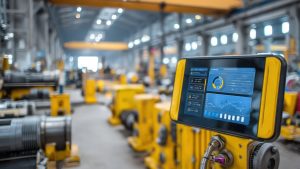Is your maintenance team overwhelmed by data? In today’s industrial landscape, equipment, and processes generate massive amounts of information. This can lead to analysis paralysis, leaving teams struggling to find valuable insights. AI for Maintenance: Turning Data Into Insights offers a solution, transforming raw data into actionable intelligence.
This approach is revolutionizing maintenance. It lets corporations flip raw statistics into actionable insights, driving performance and minimizing downtime. This concept is a practical answer, no longer just a trend. As industries become more complex, reactive renovation is not enough. We need proactive approaches that predict issues and optimize schedules.
Table of Contents:
- AI for Maintenance: Turning Data Into Insights
- The Challenge of Data Overload
- How AI Simplifies Data Management
- Benefits for Maintenance Teams
- Case Study: AI in Action
- Implementing AI for Maintenance: Best Practices
- Conclusion
AI for Maintenance: Turning Data Into Insights
The Challenge of Data Overload
Maintenance teams face a difficult task. They manage unstructured data from many sources, including sensor readings, logs, manuals, and more. This data overload can lead to missed warnings and inefficient resource allocation.
A National Institute of Standards and Technology study shows over 45% of US maintenance programs are reactive. This involves fixing equipment only after a breakdown, causing downtime and safety risks.
Manual analysis is too slow and prone to errors. Humans miss subtle patterns indicating equipment failure. AI for Maintenance offers a way to filter the noise and find valuable information, such as fraudulent transactions, forecast future needs, or plan effective preventative maintenance and repair schedules using predictive analytics AI.
How AI Simplifies Data Management
Artificial intelligence is ideal for managing data overload. Using algorithms and machine learning, AI processes large datasets faster than humans, improving data analytics for maintenance operations of all sizes.
NLP Technology: Making Sense of Unstructured Data
Natural Language Processing (NLP) helps AI understand human language. In maintenance, NLP extracts insights from unstructured data like reports and manuals.
An AI system with NLP scans service reports, finding common issues, recurring problems, and failure indicators. Processing text at scale is crucial for improving maintenance strategies. This also helps businesses use high-quality data for practical preventative maintenance strategies.
Predictive Maintenance: Forecasting Equipment Issues
A key application of AI in maintenance is predictive maintenance. AI models forecast equipment failures using historical data and identifying patterns.
Deloitte reports predictive maintenance boosts productivity by 25%, cuts breakdowns by 70%, and lowers costs by 25%. AI-driven maintenance is transformative. Early intervention is possible when high-risk individuals are easily identified.
Here’s a comparison:
| Metric | Traditional Maintenance | Predictive Maintenance |
| Downtime | High | Reduced by up to 70% |
| Maintenance Costs | High | Reduced by up to 25% |
| Productivity | Variable | Increased by up to 25% |
| Equipment Lifespan | Standard | Extended |
Real-Time Insights: Instant Updates and Recommendations
AI provides real-time updates and recommendations. Systems monitor equipment, flag anomalies, and suggest corrective actions. This can include monitoring supply chain inventory levels for preventative maintenance. Predictive maintenance helps alert maintenance teams to potential equipment failures.
Real-time capability is vital in high-stakes industries. Equipment incidents account for 32% of construction injuries, so AI can reduce repair costs and help accurately predict supply chain management needs using data analytics.
Benefits for Maintenance Teams
AI offers several advantages for maintenance. These can provide accurate predictions and forecast future maintenance needs.
Reduced Downtime
AI minimizes downtime by predicting failures. This boosts productivity and avoids the ripple effects of failures. This allows teams to detect fraudulent activities within equipment management operations.
Improved Decision-Making
AI gives teams data-driven insights for resource allocation and equipment replacement. It helps create treatment plans for customers by predicting future demand with the help of personalized marketing plans.
Cost Savings
AI significantly reduces costs. It minimizes downtime, extends equipment lifespan, and optimizes schedules. Preventative maintenance programs help lower expenses in the long term.
Enhanced Safety
Proactive maintenance enhances safety. AI helps prevent accidents by identifying potential failures early. It alerts maintenance teams and helps identify patterns, contributing to customer satisfaction through proactive issue resolution. Learning algorithms help monitor machinery and alert teams of possible problems.
Optimized Inventory Management
AI optimizes spare parts inventory by predicting needs reducing carrying costs and stockout risks. It involves using learning algorithms and neural networks. Accurate predictions of inventory levels become more efficient and manageable with the help of AI-driven predictive maintenance.
Case Study: AI in Action
An automotive manufacturer faced frequent downtime from equipment failures. They implemented AI-driven predictive maintenance.
Within six months, they achieved:
- 30% reduction in unplanned downtime.
- 25% decrease in maintenance costs.
- 15% increase in overall equipment effectiveness (OEE).
The AI system predicted failures in advance. The maintenance team scheduled repairs during planned downtime, improving efficiency and extending equipment lifespan.
Implementing AI for Maintenance: Best Practices
Implementing AI requires planning. Here are some tips.
Start with Clear Objectives
Define your goals. Do you want to reduce downtime, extend lifespan, or optimize schedules? Clear objectives guide implementation. Data governance is essential, especially when financial institutions manage sensitive data from diverse sources. Data sources may include structured and unstructured data that needs proper handling.
Ensure Data Quality
AI models need good data. Invest in data preparation and cleaning processes to ensure the AI system has accurate information to process.
Invest in Training
Train your team on using and interpreting the AI system. Comprehensive training maximizes the technology’s benefits. It helps ensure data standardization that the AI models rely on, ultimately enabling AI to predict equipment failures before breakdowns occur.
Start Small and Scale
Begin with a pilot project. Test and refine before a broader rollout. This helps demonstrate value and address issues early.
Continuously Monitor and Improve
AI improves over time with more data. Regularly review and refine your system’s predictions for increased accuracy.
Conclusion
AI for Maintenance: Turning Data Into Insights revolutionizes system management. Businesses improve upkeep strategies, reduce fees, and improve operational efficiency. AI offers massive benefits, including predicting screwups, optimizing schedules, and improving safety.
AI’s role in preservation will expand with technological advancements. Embracing AI is crucial for agencies in an information-driven global. Implementing AI for maintenance is now not a choice but a necessity to stay competitive, make knowledgeable selections, and save power fees by stopping unexpected upkeep.
AI’s potential to facilitate fact series and record evaluation is vital to improving decision-making in protection. By constantly accumulating and reading statistics from machines and systems, AI can identify patterns that might be hard for humans to spot. This lets businesses enforce predictive fashions, predicting whether equipment is likely to fail or require attention. Such insights allow proactive measures, supporting corporations in avoiding costly downtime and improving their overall performance.
The shift from reactive to preventive upkeep has been expanded with the aid of AI. Instead of anticipating devices’ failure, companies can now depend upon AI-driven insights for agenda upkeep at the most suitable times, ensuring minimum disruption to operations. This transition saves money and extends the lifespan of the device, decreasing the need for expensive maintenance and replacements.
AI is reshaping industries like financial services, where upkeep and asset control are critical. Through AI’s energy, businesses in those sectors can now control their property more efficiently, predict carrier desires, and optimize overall performance to ensure their operations continue to be cost-effective and competitive.
As AI technology adapts, it will play an even more significant role in reworking protection practices. Businesses that spend money on AI-pushed solutions today can be better located to leverage these predictive fashions inside the Destiny, ensuring that their maintenance operations are the handiest green but also resilient, sustainable, and fee-effective. By tapping into the entire capability of AI for renovation, organizations can pave the way for long-term success, stepped-forward productivity, and a greater streamlined workflow.



